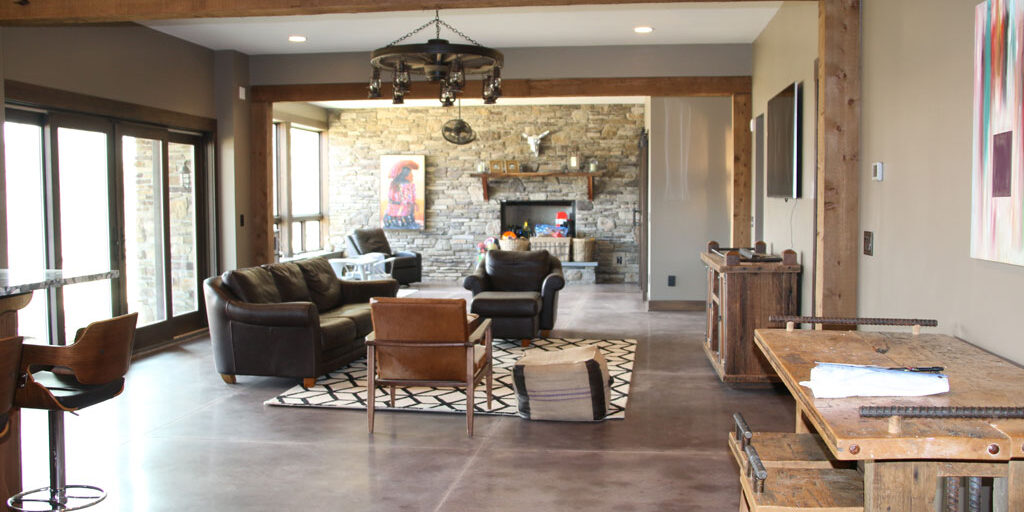Concrete is very durable and extremely resistant when it comes to wear and tear. It’s no wonder why it has become a popular option both inside and outside of the home. While concrete is very durable, in order to reduce future maintenance costs, it is important to have it properly finished. Luckily at GK’s Custom Polishing, we specialize in the cleaning, polishing, staining and finishing of concrete and other natural stone surfaces.
Different types of epoxy, stains and sealants can give concrete varying levels of protection as well as a drastically different look. In order to choose the finish that will work the best, it is important to know what benefits are to each type.

Acid Stain with Clear Coat
For those of you that want to really bring out the color in your concrete, you may want to consider an acid stain. Acid stains are known for adding color to concrete’s already elegant look. An acid stain is most popular for interior spaces like basements or living rooms. This is partially due to its ability to easily match the tone of a room.
The concrete will first be mechanically prepped with a floor machine and hand machine. This requires one grinding stage and one honing stage. The acid stain is then applied. The unique color is caused by the stain reacting with the lime in the concrete. Our technicians then apply two coats of a two-part clear urethane to the concrete. This is one of the toughest clear coats available and will allow the concrete to be resistant to scratching and chemical spills.
 Naturally Polished Finish
Naturally Polished Finish
A naturally polished finish is another popular option for interior spaces. This will give your concrete floors a highly reflective sheen when polished. This type of finish is especially popular with professional establishments like hospitals, office buildings and colleges.
The concrete is honed two additional stages after the initial stage of grinding. The honing of the concrete creates a medium sheen finish. A densifier is then applied to the concrete to harden it. At this stage, an optional water-based dye can be added to change the color of the concrete. We then apply a lithium silicate sealer. This is an impregnating sealer that chemically bonds to the concrete. Finally, the surface is burnished with a high-speed burnisher.
 Epoxy Coating (with or without color flakes)
Epoxy Coating (with or without color flakes)
An epoxy coating is a two part coating that consist of an epoxy resin and a co-reactant hardener. When the two parts combine, they create a hard chemical resistant finish. Epoxy finishes exist in a variety of different colors and can be done with or without decorative flakes. An epoxy coating generally works best on interior surfaces such as basements or living rooms.
To install an epoxy coating, the surface is mechanically prepped one grinding stage. The cracks, pits and joints are then filled. Two coats of water-based epoxy are applied to the concrete – this includes the primer and the base coat. At this point, the decorative flakes are applied with the 2nd coat of epoxy. Two coats of a two-part clear urethane are applied to the concrete. This is one of the hardest clear coats that can be applied to the concrete and allows it to be resistant to scratches and chemical spills similar to the acid stain clear coat.
 Acrylic Epoxy Coating (EXTERIOR)
Acrylic Epoxy Coating (EXTERIOR)
An acrylic epoxy coating is one of the few coatings that is safe to use outside. This type of coating is resistant to chemicals, scratches and UV rays. It is generally used when exterior concrete is in poor condition or the color needs to be changed. To apply an acrylic epoxy coating, the concrete is mechanically prepped with one grinding stage. An epoxy primer is then applied to the concrete before the acrylic coating is applied. If the surface is properly prepped beforehand, the coating will have very high durability in the future.
 Rock Epoxy
Rock Epoxy
Not interested in a shiny glossy finish? A rock epoxy coat may be your best choice. Rock epoxy will give your concrete a rough, textured look that is beautiful for exterior areas such as driveways, garages and patios. Although it is popular for garages and outdoor spaces, it also works with indoor areas like basements.
After one stage of grinding with a floor and hand machine, river rock pebbles are mixed with a two-part epoxy and are troweled over the surface of the concrete. After the mixture is applied, this will create a surface that is ½”-5/8” thick. We then apply a thin layer of epoxy as a topcoat to help protect the epoxy mixture.
If you are looking to get a project done on your concrete surface, why not let our expert technicians handle it? Click here to learn more about our state-of-the-art LAVINA® 20-S Surface Preparation & Polishing System. We service all of Northeastern Ohio including Cuyahoga, Lorain, Medina, Summit and Geauga counties. Give us a call at (440) 937-4457 or send us an email to set up your free estimate.
For more information about caring for your other surfaces (natural stone, ceramic tile, etc..), be sure to head over to our website.







